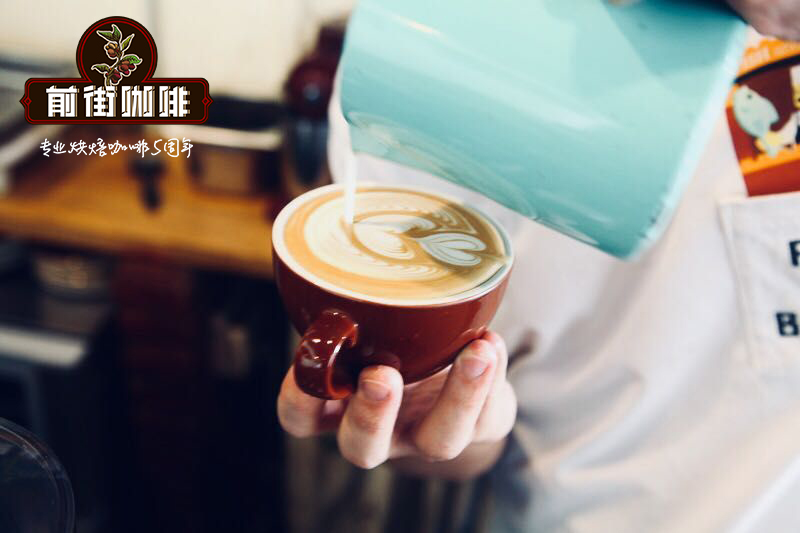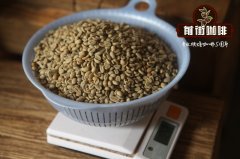What are the coffee producing areas in Ecuador? How to rinse and boil the soybeans from the producing area of Samora, Ecuador

Professional coffee knowledge exchange more coffee bean information please follow the coffee workshop (Wechat official account cafe_style)
What are the coffee producing areas in Ecuador? How to rinse and boil beans from Ecuador's Samora region?
Coffee cultivation in Ecuador covers an area of 305.000 hectares, of which Arabigo coffee accounts for 68 per cent and Robusta coffee accounts for 32 per cent. Coffee, cocoa and bananas are the three traditional crops in Ecuador, which are not only the source of farmers' income, foreign exchange for the country, but also important crops to provide employment and social stability. Due to the collapse of international coffee prices around 2000, coffee cultivation in Eritrea has gradually shrunk, and the share of coffee production in the world has also gradually declined. by 2009, Eritrea's coffee production accounted for only 1% of the world's coffee production. However, the export volume of coffee from Eritrea has gradually increased, mainly due to the developed instant coffee processing industry in Eritrea, which, in addition to home-grown coffee, still imports foreign coffee after processing and re-export. Ecuador's coffee exports have increased year by year since 2002, and the export value of coffee-related products reached more than US $100.007 million in 2010.
Second, the output of the coffee garden in Eritrea is not good:
Eighty-five percent of the coffee gardens in Ecuador are run by small farmers, lack of technical guidance, old and unrenewed tree species, so the average yield is very low and the quality is difficult to maintain.
Due to the large number of small farmers and many of them have not joined the coffee association, it is difficult to grasp the real production of coffee in Ecuador. The total output statistics of the National Coffee Association (COFENAC) often fail to reflect the actual output, and it is also interesting that external sales exceed production. According to Ecuador's export promotion and investment agency, Ecuador exported about 40955 metric tons in 2010, of which 45 per cent by weight were processed coffee (commonly known as industrial coffee, that is, extracted concentrated or instant coffee), and 55 per cent were coffee beans. However, in terms of amount, the export value of industrial coffee accounts for 65%, while coffee beans account for only 35%. This shows the importance of the coffee processing industry to Eritrea's coffee industry.
III. Distribution of coffee production in Ecuador:
The planting area of coffee gardens in Ecuador is generally small, with about 80% of coffee farmers planting less than 5 hectares, 13 per cent between 5 and 10 hectares, and only 7 per cent of more than 10 hectares. According to statistics, 20% of the land in coffee plantations is illegally occupied out of an area of about 300000 hectares in the country. According to the Ecuadorian Coffee Association, Ecuador's most important coffee producer is in MANABI province.
IV. Reasons for poor coffee production
It is estimated that compared with other countries, about 85% of the coffee plantations in Ecuador have a low unit yield, reaching only about 250 kg per hectare (sun-dried coffee beans). Brazil has a yield of 1550 kg per hectare, while Vietnam has reached 2250 kg. Only about 15% of coffee plantations are planted and harvested in a professional manner, with a yield of 750 kg per hectare.
The reason is that the vast majority of coffee trees in Ecuador are aging (about 15 to 80 years old) and, worse, a lack of professional care. In many producing areas, coffee farmers scatter coffee among vast woodlands and fail to harvest professionally due to insufficient rainfall, lack of irrigation systems, lack of funding, lack of care, failure to properly deal with insect pests and diseases. The common coffee pests in Eritrea are Broca del Fruto (small heart borer) and Minador de Hojas (Liriomyza huidobrensis), while the common diseases are Mal de Hilachas (lint disease), roya (rust class disease), ojo de gallo (Ohogaro) and mancha de hierro (iron class disease).
V. characteristics of buying and selling
The sale of coffee in Ecuador is very special, mainly from domestic buyers to small farmers to negotiate purchases. These middlemen take great pains to rush from village to village to visit farmers one by one and negotiate prices. After negotiation, the coffee is transported to a small number of coffee factories for processing, and then transferred to foreign distributors or processors. Ecuador's coffee processing industry is mainly located in the three major cities of Huiyoki, Quito and Manda, and only a few towns have traditional small artisanal processors.
VI. Import and export of coffee from Eritrea:
Although Ecuador is a coffee producer, Ecuador still imports a large amount of coffee every year after processing and export. In 2010, Ecuador imported about 3686 metric tons of coffee beans, the vast majority of which were unroasted, and the main importer was Vietnam.
Most southern farms are organic and produce a wide variety of products, including flowers, corn, kale, bananas, bees, cattle, fish, fruit and coffee. At present, the most difficult challenge for coffee farmers is leaf embroidery disease, which has reduced Colombia's coffee production by 50% in recent years. The easiest way to eliminate leaf embroidery disease is to use chemicals, but coffee farmers treat it in an organic but difficult way for the sake of environmental protection. In addition, in Ecuador, because of the lack of fertilization, plants are very deficient in nutrients, which also affects the quality of coffee and the growth of coffee inner shell and raw beans.
The farms in the north are large, with an average of 15 hectares or more, cultivated with traditional fertilizers and fully developed; the area is lush and very humid, coupled with warm summers, and the conditions are perfect for growing coffee; it is a very interesting place with ancient local aboriginal graveyards, vineyards and experimental farms run by NESPRESSO.
Origin: Ecuador
Production area: Erzamora Chinchipe province, Zumba city
Farm: multiple small coffee farmers
Coffee variety: Arabica
Altitude: 1300 Murray 1900m
Raw bean treatment: washing treatment, drying in the sun on the farm
Coffee flavor
"toffee and walnut flavor with citrus acid."
How to make Ecuadorian water to wash beans?
Recommended cooking methods: siphon, hand flushing
Degree of grinding: 3.5 (Japanese little Fuji R440)
KONO filter cup, 15 grams of powder, water temperature 88-90 degrees, grinding 4, ratio of water to powder close to 1:15
Steaming in 30 grams of water for 30 seconds
Segment: water injection to 120ml cut off, slow water injection to 225ml
Important Notice :
前街咖啡 FrontStreet Coffee has moved to new addredd:
FrontStreet Coffee Address: 315,Donghua East Road,GuangZhou
Tel:020 38364473
- Prev

How much is the authentic Blue Mountain Coffee? how much is the Blue Mountain Coffee Bean? how much is the Blue Mountain Coffee Bean?
Professional coffee knowledge exchange more coffee bean information please follow the coffee workshop (Wechat official account cafe_style) Jamaica Blue Mountain coffee bean is one of the world's top boutique coffee, and the Blue Mountain name is due to the local haze, in the sun seems to be a layer of blue smoke, hence the name, and this fog can lower the temperature, very suitable for coffee trees
- Next

What is the taste and flavor of Bolivian coffee Linda washed with long beans? How do you rush Bolivia?
Professional coffee knowledge exchange more coffee bean information please follow the coffee workshop (Wechat official account cafe_style) Bolivian coffee Linda washed long beans taste and flavor? How to wash beans with Bolivian coffee water before it tastes good? Bolivia is one of the most difficult growing areas in the world, and transportation and climate are the biggest problems. This year, after a special relationship of origin,
Related
- Detailed explanation of Jadeite planting Land in Panamanian Jadeite Manor introduction to the grading system of Jadeite competitive bidding, Red bid, Green bid and Rose Summer
- Story of Coffee planting in Brenka region of Costa Rica Stonehenge Manor anaerobic heavy honey treatment of flavor mouth
- What's on the barrel of Blue Mountain Coffee beans?
- Can American coffee also pull flowers? How to use hot American style to pull out a good-looking pattern?
- Can you make a cold extract with coffee beans? What is the right proportion for cold-extracted coffee formula?
- Indonesian PWN Gold Mandrine Coffee Origin Features Flavor How to Chong? Mandolin coffee is American.
- A brief introduction to the flavor characteristics of Brazilian yellow bourbon coffee beans
- What is the effect of different water quality on the flavor of cold-extracted coffee? What kind of water is best for brewing coffee?
- Why do you think of Rose Summer whenever you mention Panamanian coffee?
- Introduction to the characteristics of authentic blue mountain coffee bean producing areas? What is the CIB Coffee Authority in Jamaica?

